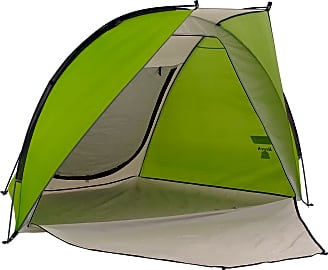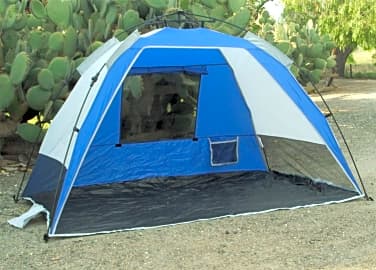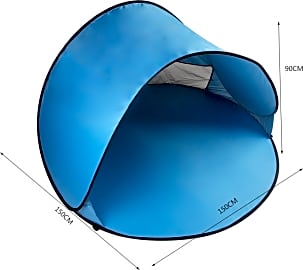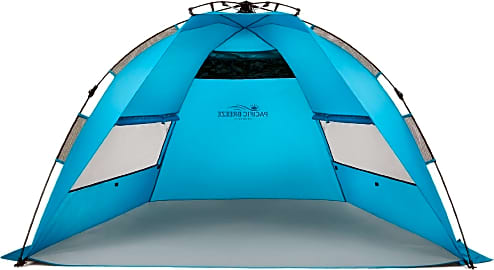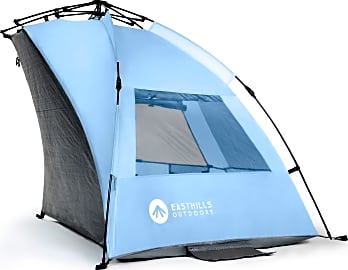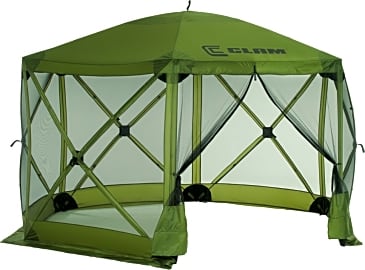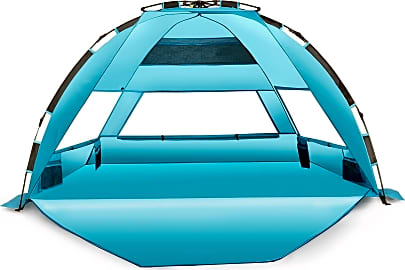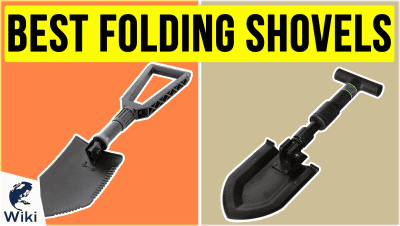The 10 Best Beach Shelters

This wiki has been updated 39 times since it was first published in April of 2015. Nothing can ruin a day at the shore faster than a sunburn or bad weather. That's why savvy beachgoers take a shelter with them to protect them from the elements. Coming in cabana and tent styles, these models are durable and lightweight, and let you enjoy the outdoors all day while always having a place to retreat to, if necessary. When users buy our independently chosen editorial picks, we may earn commissions to help fund the Wiki.
Editor's Notes
April 14, 2019:
A good shelter is a fantastic addition to any trip to the beach, and not just for comfort, but also safety purposes. You don't have to spend a lot; many of the best choices are well under $100. Some, like the Arcshell, Easthills, Lightspeed, and Pacific options feature a pre-constructed hub and frame that are particularly easy to set up. The Aigo is even easier to get ready, as it basically unfolds itself in less than a minute. Ventilation is also important, because if there's no airflow, it can be uncomfortably hot inside. The Coleman has a large rear window that also acts as an entry point and breezeway, while the Pacific Breeze and Lightspeed Cabana offer multiple windows that can keep air flowing inside. The Coleman also features a fully closing zipper so you can change in private, as does the Easthills. The Sport-Brella is an interesting choice because if you don't need to be completely surrounded on a particular day, it can also act as a normal beach umbrella. And if you're part of a large group, for example having a family picnic, the Clam is a great choice. While it's rather costly and bulky, it's large enough for a decent-size table inside, and tall enough for everyone to stand up.
Which Type of Beach Shelter Makes The Most Sense for You?
Most Dome models can be zipped open or shut, providing varying levels of privacy, or protection from the elements, depending on your needs.
Believe it or not, beach shelters are not a one-size-fits-all proposition. Different companies manufacture different styles. And yet the majority of beach shelters still fall into three basic categories. Below we've provided a breakdown of each one:
1. The Dome. This is the most common type of beach shelter. It has a wide and rounded top with an open face toward the front. Most Dome models can be zipped open or shut, providing varying levels of privacy, or protection from the elements, depending on your needs. Domes are the most popular type of beach shelters because they look cool, they offer room for 2-3 people, and they're easy to assemble or take apart. If you're a person with a small family who enjoys an occasional outing at the beach, a dome is probably your best bet.
2. The Gazebo. A gazebo isn't so much an honest "shelter" as it is a miniature party tent - five poles and a durable canopy that stretches tight overhead. These structures mark your territory, while also allowing enough room for standing - or even barbecuing - underneath. Gazebos block the sun, but not the wind. They are ideal for any group that is slightly larger than the traditional family, and they make just as much sense at a state park or a tailgating party as they do at the beach.
3. The Fly Tent. A fly tent is your basic triangular piece of fabric held up by several poles, perhaps even anchored by some rope and stakes (think Boy Scout tent, and you're on the right track). Fly tents are inexpensive, but they look odd on a beach. You can recline or sleep inside these shelters, but otherwise they're mostly designed for keeping delicate items in the shade.
What Do I Need to Know About A Beach Shelter Before I Buy?
The first thing you need to know is how many people you plan on taking with you during an average trip to the beach. Next, you'll want to read some product descriptions so you can start to gain a grasp of what differentiates a mediocre beach shelter from a great one. How much does each model weigh? What does the manufacturer say about assembly? Does the shelter come with a carrying case? Does that carrying case have wheels? Does it have straps or handles, ala a backpack? Does the open-ended front section of the shelter zip up for occasional privacy? Does the shelter feature plastic windows, or pouches, or zip-down storage sections inside?
Once you've gotten answers to these questions, scroll down to read some of the customer reviews. Don't be dissuaded by a single negative review. What you're looking for are consistent patterns, any selling points or complaints that rear their head again and again. Patterns represent a significant indication that you'll want to take something into account before you buy. On top of which, customers tend to be more straightforward - and emotional - than manufacturers. Customers also have the benefit of having lived with the product for a while.
Along those lines, be sure to check out what type of material each shelter is made of. Polyurethane (sometimes abbreviated as "PU" in product descriptions) is the industry standard. If the shelter's lining is made of this material, chances are it'll be both reliable and light.
A Very Brief History Of The Beach Shelter
Casual observers might look at a photo of an average beach shelter and think, Hey, wait a minute, isn't this thing just a tent? And the truth is, for the most part, those casual observers would be correct. Beach shelters are nothing more than a marketing term for what was originally known as a "beach tent." Beach tents were a derivative of the more traditional camping tents. Both structures were made of the same materials, both were built to stand up to the elements. In fact, the only aspects that differentiated an early beach tent from a similarly-shaped camping tent were an open front and a smaller size.
Both structures were made of the same materials, both were built to stand up to the elements.
While most Americans have come to associate a "tent" with camping, these structures, which date all the way back to The Iron Age, were originally used to provide protection in the deserts, along with any arid lands. This, of course, means that a modern-day beach shelter serves the same basic purpose that was originally intended for a tent.
All irony aside, the popularity of beach shelters in America grew as an extension of the free-standing beach umbrella. Today's beachgoers can enjoy all of the shade originally provided by an umbrella along with an increased barrier of protection thanks to a shelter. What's more, beach shelters stand up to wind a lot more effectively than beach umbrellas do. Comparatively speaking, it'd take a significant gale to send someone sprinting down the beach after a 7-lb. shell.



